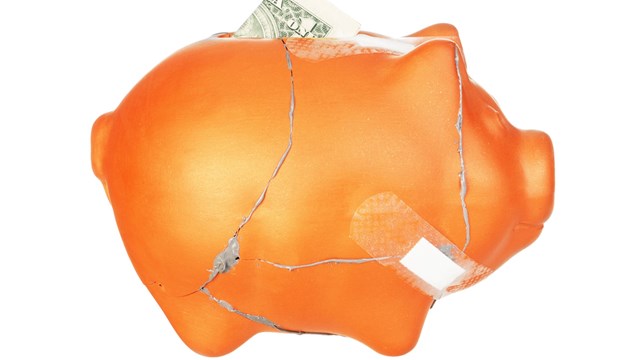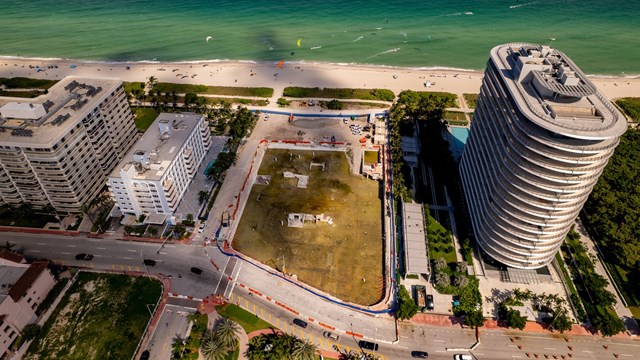These days, when a condo’s fencing, decking or siding wears out and needs replacement, smart boards are looking well beyond “apple-for-apple” replacement materials.
Wood siding, a favorite for decades, is frequently being replaced by vinyl, or even fiber cement, both of which can mimic the look of wood. When wood decks fail, lumber is being replaced by a variety of composite materials. And in fencing, failing wood is steadily being replaced by polyvinyl chloride (PVC).
Because decks, fences and siding have to be repaired and replaced so often, condos that utilize newer materials that need less maintenance can realize considerable savings over time—and that's a good thing no matter what the economic climate.
Fenced In
Fencing materials are up against a lot—wayward baseballs, weed-whackers, leg-lifting pets but according to the pros, the top two culprits in fencing deterioration are none of the above.
“It's a combination of both age and weather,” says Brian Hefferon of Master Wire MFG Inc. in Hammonton. “Age has a lot to do with it, how long it's going to hold up in the weather and in the environment depends on the type of material used."
There are four kinds of fencing generally used by suburban community associations: chain-link, wood, PVC and ornamental. Chain-link is cheaper than wood, which is cheaper than PVC. Ornamental fences, the priciest of all, are usually made of expensive metals like wrought iron, aluminum or steel.
When the primary purpose is security, chain-link is usually the way to go. Placed around the entire perimeter of a property, the tennis court or swimming pool area, chain-link does the job, but is not exactly the most attractive option.
Inexpensive, attractive, and reliable, wood has traditionally been the fence of choice—but this is changing, says Hefferon. "Wood has sort of faded away because it's too much maintenance and to keep it looking decent you've got to treat it or maintain it on a regular annual basis," he says. "Most customers want maintenance-free, which is basically what all of us want in our life. So that's where the fencing industry has gone over the past several years as well. They've expanded on the vinyl products. Most of it originally was white, but now they've come out in the past two years or so with these new natural wood grains that look just like the real thing."
“We’re seeing more and more PVC fencing in condo properties that had wood fences,” agrees Bill Taylor, project manager with Premier Fence in Avon, Massachusetts. The reason, Taylor says, is the desire to reduce maintenance costs to virtually zero with PVC. “You're seeing a lot of wood being replaced with vinyl because of the value for the buck... Homeowners are not looking for maintenance, they want low maintenance—something that's going to last a lifetime. They don’t have to worry about rotting out. It (PVC) doesn't have to be maintained [painted] with color; it’s already colorized.”
PVC is impervious to water damage and mold. It lasts far longer than wood—so long, in fact, that PVC fencing generally comes with a lifetime guarantee. PVC doesn’t need to be painted, just power-washed every few years, and it doesn’t splinter. In the past, the relatively steep price of the material made PVC fencing prohibitively expensive but the professionals say that’s not really the case anymore as its cost has dropped to about 25 percent more than wood.
Earlier problems with PVC fencing not holding its color have been mostly solved in today’s quality products, says Taylor. “It’s not an issue with the brand that we carry but with some of the lesser-quality products it’s still an issue. When buying a PVC fence it’s good to know a little bit about the company that you’re dealing with."
Side of the Times
According to Brian Bolger of Tri-County Construction in Edison, weather is a factor in replacing siding because siding gets blown off. “Rain, wind and snow can contribute to when it’s time to change siding because there’s flashing.” Condo communities looking at replacement siding have a number of options: traditional wood, vinyl, composite-based vinyl, cement and synthetic stucco, or EIFS (Exterior Insulation and Finish Systems).
From an economic standpoint, vinyl siding is the least expensive to install and maintain. According to Fernando Pagés Ruiz, a builder/developer and author of the book Affordable Remodeling, “Vinyl siding enjoys the longest manufacturer warranties in the industry—25 to 75 years—and it’s durable in all weather applications. If you have to replace it, it's typically because of installation defects. Unless your vinyl is 50 years old, or you live outside the climate zones within the USA, the reasons to replace vinyl siding are either aesthetic or because of construction defects of the vinyl installation or the surfaces below it. [When siding fails,] it's common for building owners to blame the vinyl, only to discover the defects actually relate to flashing, insulation, etc."
And a “reason to replace vinyl siding is that it gets ugly,” says Bolger. “The actual siding panel will lasts for years and years, but it will ugly out.”
Another plus for vinyl siding is color—different products are manufactured in a wide array of colors, says Pagés Ruiz, but should you need to replace just a section of existing vinyl siding on an individual building, you can order a custom color blend. The larger manufacturers will custom make a batch of siding using the same color-match technology available at a paint store, sparing the expense of having to re-side the entire structure to match the patch.
Another option, fiber cement, has its pros and cons as well. It still needs to be painted, like wood, but it lasts much longer, is impervious to water, and needs very little maintenance. However, fiber cement does cost much more than wood—and about three times as much as conventional vinyl siding.
If a condominium is in a historic district—or it just wants to retain its heritage—traditional wood siding may be the only option.
However, the professionals warn that wood siding needs extra preparation before it’s installed. For example, it's important that the material is back-primed, and that all four sides and both ends of the lumber being used have been treated with wood preservative to maximize its useful life. It's also vital that the board and management commit to a regular maintenance schedule to get the most out of the newly-installed wood.
Synthetic stucco or Exterior Insulation and Finish Systems (EIFS) has had a checkered history because of installation problems that occurred decades ago but siding experts say that those problems have largely been solved. Like any other manufactured material, it's important that EIFS is installed by a certified contractor. “If you're using a material that the manufacturer does train and certify installers, by all means check for this," says one siding installer."You also check that it's a current certification, and that the crew working on your project is actually the crew that was certified by the company. You really have to check the details because that company may have five different crews and in only one of them has actually been trained and certified [for the product].”
On Deck
Wood still dominates as the material of choice for decks. “It’s a less expensive material to use to build a deck as opposed to a concrete deck,” says Bolger about the benefits of using wood. Many condos are choosing a variety of composite lumber alternatives, which contain a combination of [fine particle] wood with polymers or plastics. "As with any plastic," says Pagés Ruiz, "these should not require replacement—only cleaning, unless you don’t like the way they look or they were installed poorly and those defects have begun to show. Some composite decks can be renewed with latex, solid body stains."
The Trex brand is an industry standard in composite, but Veranda, Trimax and Deck Lok are also well-respected. Their consistency of color and shape, uniformity and durability, along with their lack of maintenance requirements, make them a good choice for condos. Composites are considerably more costly than wood, but can last decades with almost no maintenance if properly installed.
When installing composites, it’s a good practice to use hidden screws instead of a top-fastening screw. Hidden screws make it much harder for water to penetrate the board and cause failure.
Another common failing in deck construction is surface tilt sending water the wrong way—on an incline toward the condo—which allows water to accumulate on the decking. When installing a deck, close attention needs to be paid to the footers, experts say. Footers that are placed deep into the ground will resist being pushed by frost heaves, and won’t tilt the deck into the building.
Another synthetic option for decking is mineral-added HDPE [high-density polyethylene] plastic lumber. Made from 100 percent recycled materials, no trees are destroyed to manufacture this product, and it releases no toxic chemicals or greenhouse gases into the environment. Plastic is typically softer than wood or wood-composites, however, and is susceptible to expansion and contraction from variable temperatures. To compensate, some manufacturers add recycled materials and minerals. Tangent Technologies and EPS are major manufacturers.
Concrete is even used sometimes for deck surfacing—though it is prone to its own set of weak points, says Pagés Ruiz. "Concrete decks crack, stain, pit, and sometimes look awful, but generally remain functional," he says. "Concrete is much easier to maintain, especially in a snowy area, and while wood is often cheaper, and sometimes nicer, it's never more durable. You can actually use stamps to make concrete appear like wood, and stains to approximate the look with uncanny realism."
Working With Your Professionals
When a condo is looking at alternatives to its existing materials, it’s important that the association work closely with a good engineering or reserve firm to carefully look at the cost and benefits of any material over a number of years. It's also important to vet out your installers, say the pros.
“You should look for someone who has multiple years of on-site experience,” says Bolger. “Someone who has worked closely with the engineering company, someone who has a good general knowledge about multiple materials, not just one type.”
"Referrals are also huge,” adds Hefferon. “You need to look for referrals, the length of time the company's been in business, check with the Better Business Bureau to see if there are any complaints filed against them, or any repetitive complaints. Those are the ones you want to stay away from."
And even though saving money is on everybody's mind these days, the cheapest deal is not always the best deal. "Sometimes people only shop price, price, price," says Hefferon. "They don't realize that you can cut corners as much as you want, but the bottom line is do you want the job done right, without headaches—no change orders going on in the middle of the project saying, 'We didn't discuss this, but we need to add on another $2,000,' or whatever."
"With builders going out of business, warranties are worth little," adds Pagés Ruiz. "Most issues relate to installation, and rarely to product failures. Products do fail of course, and if the manufacturer is strong, they may be around to help you remedy the situation. So by all means insist on strong, written warranties. If a manufacturer has certified installers and is willing to warranty their work—then this has some meat. Often the manufacturer will inspect the work in progress. Otherwise, your only guarantee is good workmanship. Hire the best installers."
By using due diligence when choosing newer materials, a condo can minimize maintenance while maximizing value for its owners.
Jim Douglass is managing editor of New England Condominium magazine, a Yale Robbins’ publication. Editorial Assistant David Chiu and freelance writer Keith Loria contributed to this report.







Leave a Comment